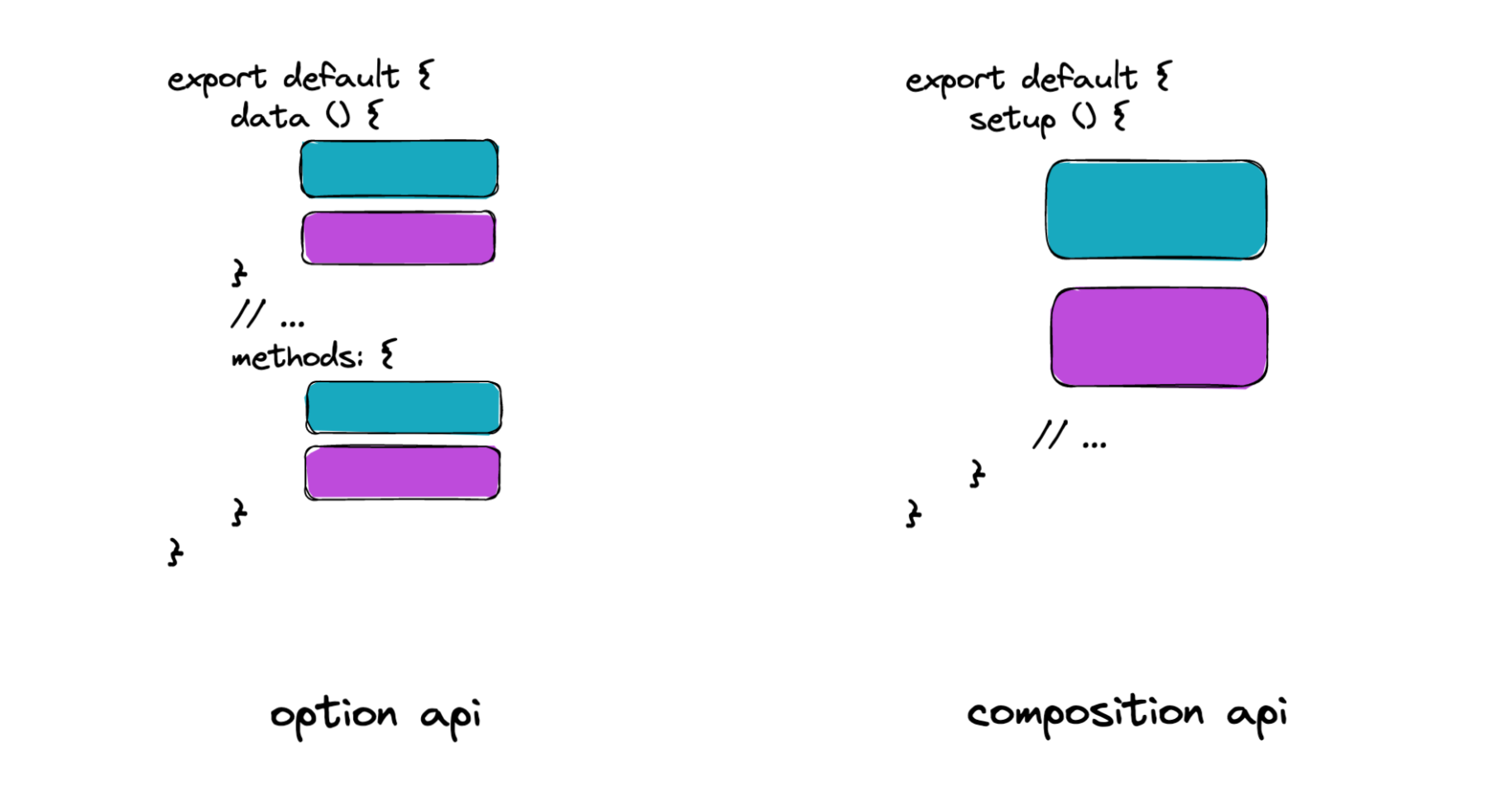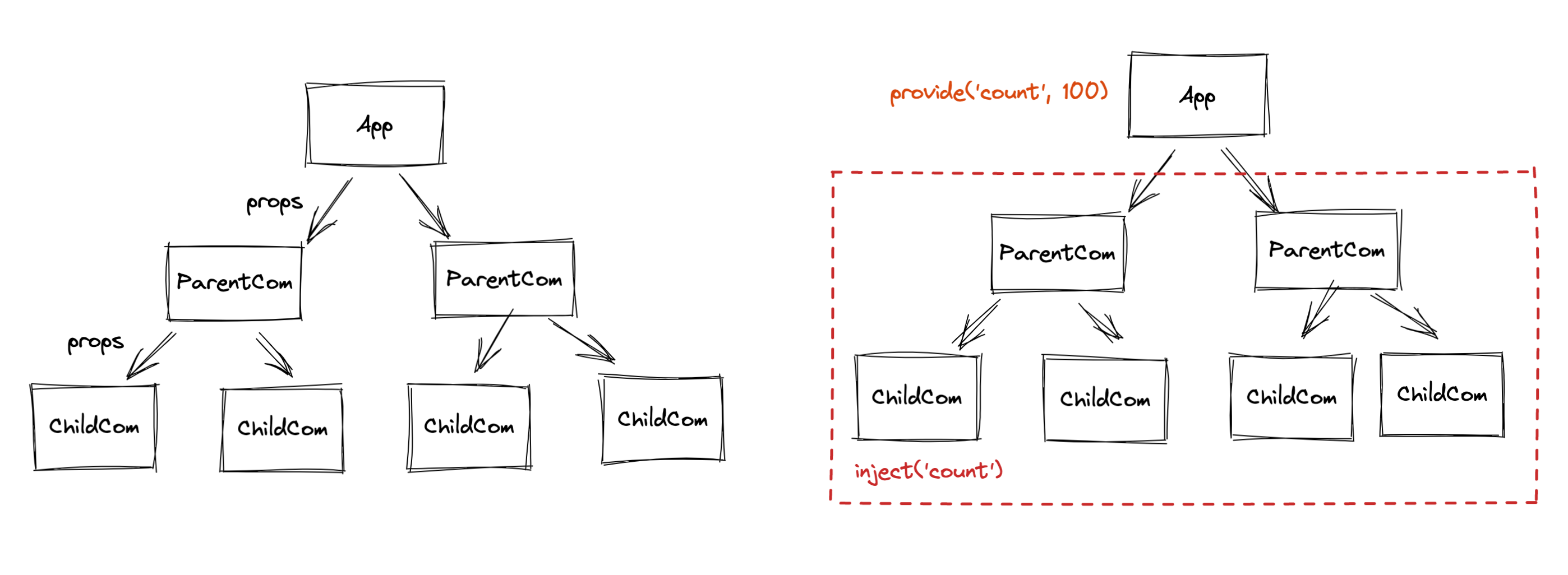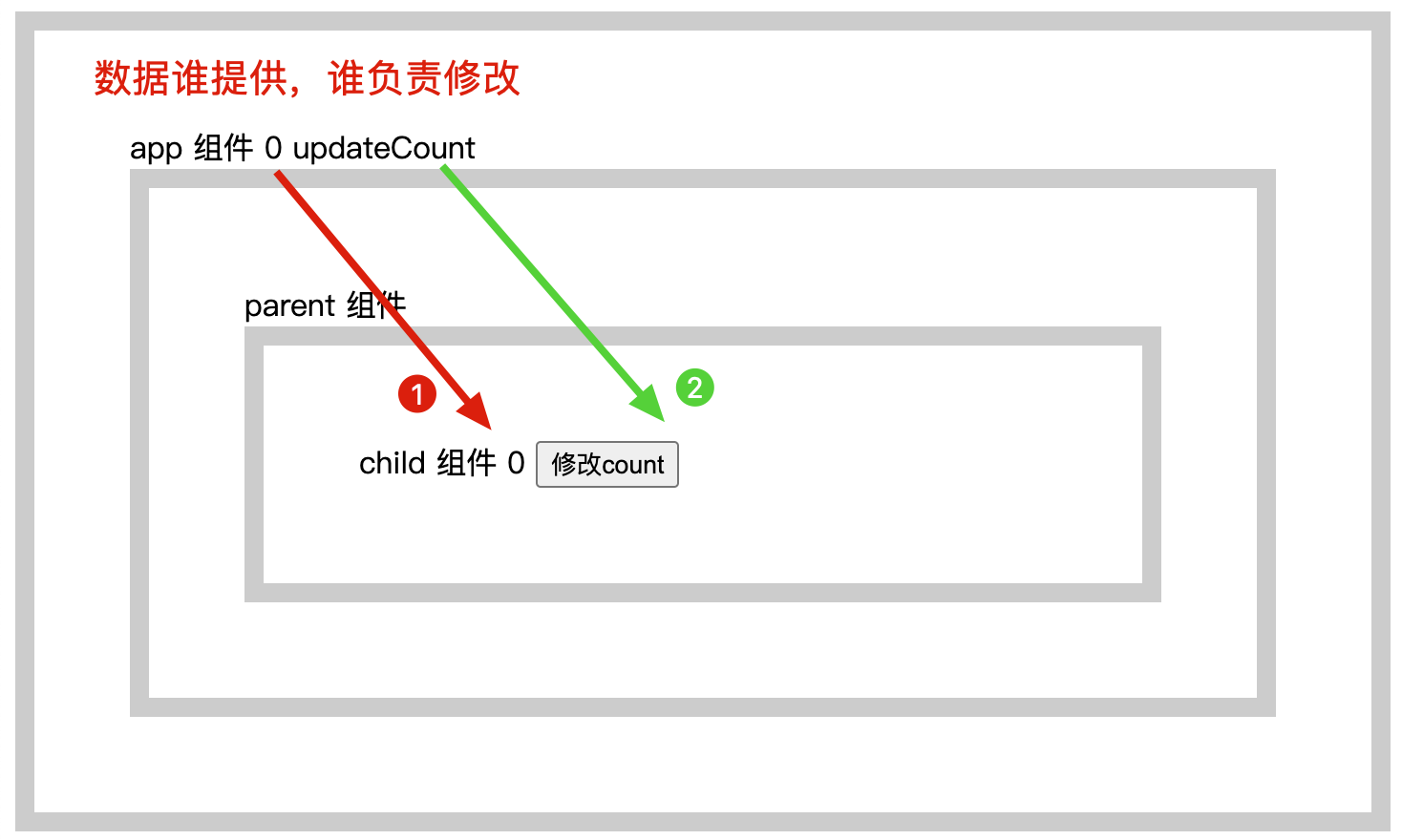CompositionAPI
组合式API介绍
介绍:什么是组合式API,组合式API的特点
Vue3提供两种组织代码逻辑的写法:
- 通过data、methods、watch 等配置选项组织代码逻辑是
选项式API写法 - 所有逻辑在setup函数中,使用 ref、watch 等函数组织代码是
组合式API写法
准备了两份代码实现同一些功能,做对比:

option api
vue
<template>
<button @click="toggle">显示隐藏图片</button>
<img v-show="show" alt="Vue logo" src="./assets/logo.png" />
<hr />
计数器:{{ count }} <button @click="increment">累加</button>
</template>
<script>
export default {
data() {
return {
show: true,
count: 0,
};
},
methods: {
toggle() {
this.show = !this.show;
},
increment() {
this.count++;
},
},
};
</script>
1
2
3
4
5
6
7
8
9
10
11
12
13
14
15
16
17
18
19
20
21
22
23
24
2
3
4
5
6
7
8
9
10
11
12
13
14
15
16
17
18
19
20
21
22
23
24
composition api
vue
<template>
<button @click="toggle">显示隐藏图片</button>
<img v-show="show" alt="Vue logo" src="./assets/logo.png" />
<hr />
计数器:{{ count }} <button @click="increment">累加</button>
</template>
<script>
// ref 就是一个组合式API
import { ref } from 'vue';
export default {
setup () {
// 显示隐藏
const show = ref(true)
const toggle = () => {
show.value = !show.value
}
// 计数器
const count = ref(0)
const increment = () => {
count.value ++
}
return { show, toggle, count, increment }
}
};
</script>
1
2
3
4
5
6
7
8
9
10
11
12
13
14
15
16
17
18
19
20
21
22
23
24
25
26
2
3
4
5
6
7
8
9
10
11
12
13
14
15
16
17
18
19
20
21
22
23
24
25
26

总结
- 在setup中通过vue提供的函数组织代码实现功能,就是组合式API写法。
- 组合式API有什么好处?可复用,可维护
- ref 是不是一个组合式API?是
setup函数
setup函数是组合式API的入口函数
setup函数是Vue3特有的选项,作为组合式API的起点- 从组件生命周期看,它在
beforeCreate之前执行 - 函数中
this不是组件实例,是undefined - 如果数据或者函数在模板中使用,需要在
setup返回
vue
<template>
<div class="container">
<h1 @click="say()">{{msg}}</h1>
</div>
</template>
<script>
export default {
setup () {
console.log('setup执行了')
console.log(this)
// 定义数据和函数
const msg = 'hi vue3'
const say = () => {
console.log(msg)
}
// 返回给模板使用
return { msg , say}
},
beforeCreate() {
console.log('beforeCreate执行了')
console.log(this)
}
}
</script>
1
2
3
4
5
6
7
8
9
10
11
12
13
14
15
16
17
18
19
20
21
22
23
24
25
2
3
4
5
6
7
8
9
10
11
12
13
14
15
16
17
18
19
20
21
22
23
24
25
总结:
- 今后在vue3的项目中几乎用不到
this, 所有的东西通过函数获取。
reactive函数
通常使用它定义 对象类型 响应式数据
疑问:以前在 data 函数中返回对象数据就是响应式的,现在 setup 中返回对象数据是响应式的吗?
- 不是,需要使用
reactive转成响应式
使用步骤:
- 从
vue中导出reactive函数 - 在
setup函数中,使用reactive函数,传入一个普通对象,返回一个响应式数据对象 - 最后
setup函数返回一个对象,包含该响应式对象即可,模板中可使用
vue
<template>
<div>
<p>姓名:{{state.name}}</p>
<p>年龄:{{state.age}} <button @click="state.age++">一年又一年</button></p>
</div>
</template>
<script>
// 1. 导入函数
import { reactive } from "vue";
export default {
setup() {
// 2. 创建响应式数据对象
const state = reactive({ name: 'tom', age: 18 })
// 3. 返回数据
return { state }
}
};
</script>
1
2
3
4
5
6
7
8
9
10
11
12
13
14
15
16
17
18
19
2
3
4
5
6
7
8
9
10
11
12
13
14
15
16
17
18
19
总结:
reactive函数通常定义:复杂类型的响应式数据可以转换简单数据吗?不能
ref函数
通常使用它定义响应式数据,不限类型
使用步骤:
- 从
vue中导出ref函数 - 在
setup函数中,使用ref函数,传入普通数据(简单or复杂),返回一个响应式数据 - 最后
setup函数返回一个对象,包含该响应式数据即可 - 注意:使用
ref创建的数据,js中需要.value,template中可省略
落地代码:
vue
<template>
<div>
<p>
计数器:{{ count }}
<button @click="count++">累加1</button>
<!-- template中使用可省略.value -->
<button @click="increment">累加10</button>
</p>
</div>
</template>
<script>
// 1. 导入函数
import { ref } from "vue";
export default {
setup() {
// 2. 创建响应式数据对象
const count = ref(0);
const increment = () => {
// js中使用需要.value
count.value += 10;
};
// 3. 返回数据
return { count, increment };
},
};
</script>
1
2
3
4
5
6
7
8
9
10
11
12
13
14
15
16
17
18
19
20
21
22
23
24
25
26
27
2
3
4
5
6
7
8
9
10
11
12
13
14
15
16
17
18
19
20
21
22
23
24
25
26
27
总结:
ref可以把简单数据或者复杂数据转换成响应式数据,注意使用加上.value,不过模板可省略。- 疑问:定义响应式数据使用
ref还是reactive呢?
reactive 与 ref 的选择
知道:在定义响应式数据的时候如何选择reactive和ref
开始分析:
reactive可以转换对象成为响应式数据对象,但是不支持简单数据类型。ref可以转换简单数据类型为响应式数据对象,也支持复杂数据类型,但是操作的时候需要.value。- 它们各有特点,现在也没有最佳实践,没有明显的界限,所有大家可以自由选择。
推荐用法:
- 如果能确定数据是对象且字段名称也确定,可使用
reactive转成响应式数据,其他一概使用ref。这样就没有 心智负担 。
参考代码:
js
// 1. 明确表单对象有两个字段
const form = reactive({
username: '',
password: ''
})
// 2. 后台返回的数据对象
const data = ref(null)
const res = await axios.get('/user/100')
data.value = res.data
1
2
3
4
5
6
7
8
9
10
2
3
4
5
6
7
8
9
10
总结:
- 在定义响应式数据的函数选择上,遵循:尽量使用
ref函数支持所有场景,确定字段的对象使用reactive可以省去.value。
setup语法糖
简化 setup 固定套路代码 ,让代码更简洁
发现:
- 使用 setup 有几件事必须做:默认导出配置选项,setup函数声明,返回模板需要数据与函数。
vue
<script>
export default {
setup() {
const say = () => console.log('hi')
return { say }
}
}
</script>
1
2
3
4
5
6
7
8
2
3
4
5
6
7
8
解法:
- 使用 setup 语法糖
vue
<script setup>
const say = () => console.log('hi')
</script>
1
2
3
2
3
案例:体验一下
vue
<script setup>
// 显示隐藏
const show = ref(true)
const toggle = () => {
show.value = !show.value
}
// 计数器
const count = ref(0)
const increment = () => {
count.value ++
}
</script>
<template>
<button @click="toggle">显示隐藏图片</button>
<img v-show="show" alt="Vue logo" src="./assets/logo.png" />
<hr />
计数器:{{ count }} <button @click="increment">累加</button>
</template>
1
2
3
4
5
6
7
8
9
10
11
12
13
14
15
16
17
18
19
2
3
4
5
6
7
8
9
10
11
12
13
14
15
16
17
18
19
小结:
- 在
script setup中的顶层变量都可以在模板使用,数据,函数,组件。
computed函数
掌握:使用 computed 函数定义计算属性
大致步骤:
- 从
vue中导出computed函数 - 在
setup函数中,使用computed函数,传入一个函数,函数返回计算好的数据 - 最后
setup函数返回一个对象,包含该计算属性数据即可,然后模板内使用

落地代码:
vue
<script setup>
import { ref, computed } from "vue";
const scoreList = ref([80, 100, 90, 70, 60]);
// 计算属性
const betterList = computed(() => scoreList.value.filter((item) => item >= 90));
// 改变数据,计算属性改变
setTimeout(() => {
scoreList.value.push(92, 66);
}, 3000);
</script>
<template>
<div>
<p>分数:{{ scoreList }}</p>
<p>优秀:{{ betterList }}</p>
</div>
</template>
1
2
3
4
5
6
7
8
9
10
11
12
13
14
15
16
17
18
19
2
3
4
5
6
7
8
9
10
11
12
13
14
15
16
17
18
19
总结:
- 使用
computed定义计算属性,场景:当需要依赖一个数据得到新的数据使用计算属性
watch函数
掌握:使用watch函数监听数据的变化
大致内容:
- 使用
watch监听一个响应式数据 - 使用
watch监听多个响应式数据 - 使用
watch监听响应式对象数据中的一个属性(简单) - 使用
watch监听响应式对象数据中的一个属性(复杂),配置深度监听 - 使用
watch监听,配置默认执行
落地代码:
- 使用
watch监听一个响应式数据
vue
<script setup>
import { ref, watch } from "vue";
const count = ref(0);
// 1. 监听一个响应式数据
// watch(数据, 改变后回调函数)
watch(count, () => {
console.log("count改变了");
});
// 2s改变数据
setTimeout(() => {
count.value++;
}, 2000);
</script>
<template>
<p>计数器:{{ count }}</p>
</template>
1
2
3
4
5
6
7
8
9
10
11
12
13
14
15
16
17
2
3
4
5
6
7
8
9
10
11
12
13
14
15
16
17
- 使用
watch监听多个响应式数据
vue
<script setup>
import { reactive, ref, watch } from "vue";
const count = ref(0);
const user = reactive({
name: "tom",
info: {
gender: "男",
age: 18,
},
});
// 2. 监听多个响应式数据
// watch([数据1, 数据2, ...], 改变后回调函数)
watch([count, user], () => {
console.log("数据改变了");
});
// 2s改变数据
setTimeout(() => {
count.value++;
}, 2000);
// 4s改变数据
setTimeout(() => {
user.info.age++;
}, 4000);
</script>
<template>
<p>计数器:{{ count }}</p>
<p>
姓名:{{ user.name }} 性别:{{ user.info.gender }} 年龄:{{ user.info.age }}
</p>
</template>
1
2
3
4
5
6
7
8
9
10
11
12
13
14
15
16
17
18
19
20
21
22
23
24
25
26
27
28
29
30
31
32
33
34
2
3
4
5
6
7
8
9
10
11
12
13
14
15
16
17
18
19
20
21
22
23
24
25
26
27
28
29
30
31
32
33
34
- 使用
watch监听响应式对象数据中的一个属性(简单)
vue
<script setup>
import { reactive, watch } from "vue";
const user = reactive({
name: "tom",
info: {
gender: "男",
age: 18,
},
});
// 3. 监听响应式对象数据的一个数据,简单类型
// watch(()=>数据, 改变后回调函数)
watch(()=>user.name, () => {
console.log("数据改变了");
});
// 2s改变数据
setTimeout(() => {
user.name = 'jack';
}, 2000);
// 4s改变数据
setTimeout(() => {
user.info.age = 60;
}, 4000);
</script>
<template>
<p>
姓名:{{ user.name }} 性别:{{ user.info.gender }} 年龄:{{ user.info.age }}
</p>
</template>
1
2
3
4
5
6
7
8
9
10
11
12
13
14
15
16
17
18
19
20
21
22
23
24
25
26
27
28
29
2
3
4
5
6
7
8
9
10
11
12
13
14
15
16
17
18
19
20
21
22
23
24
25
26
27
28
29
- 使用
watch监听响应式对象数据中的一个属性(复杂),配置深度监听
vue
<script setup>
import { reactive, watch } from "vue";
const user = reactive({
name: "tom",
info: {
gender: "男",
age: 18,
},
});
// 4. 监听响应式对象数据的一个数据,复杂类型
// watch(()=>数据, 改变后回调函数, {deep: true})
watch(
() => user.info,
() => {
console.log("数据改变了");
},
{
// 开启深度监听
deep: true,
}
);
// 2s改变数据
setTimeout(() => {
user.info.age = 60;
}, 2000);
</script>
<template>
<p>
姓名:{{ user.name }} 性别:{{ user.info.gender }} 年龄:{{ user.info.age }}
</p>
</template>
1
2
3
4
5
6
7
8
9
10
11
12
13
14
15
16
17
18
19
20
21
22
23
24
25
26
27
28
29
30
31
32
2
3
4
5
6
7
8
9
10
11
12
13
14
15
16
17
18
19
20
21
22
23
24
25
26
27
28
29
30
31
32
- 使用
watch监听,配置默认执行
diff
{
// 开启深度监听
deep: true,
+ // 默认执行一次
+ immediate: true
}
1
2
3
4
5
6
2
3
4
5
6
总结:
watch(需要监听的数据,数据改变执行函数,配置对象)来进行数据的侦听- 数据:单个数据,多个数据,函数返回对象属性,属性复杂需要开启深度监听
- 配置对象:
deep深度监听immediate默认执行
生命周期函数
掌握:vue3的常用生命周期函数
使用步骤:
- 先从vue中导入以
on打头的生命周期钩子函数 - 在setup函数中调用生命周期函数并传入回调函数
- 生命周期钩子函数可以调用多次
具体内容:
- Vue3和vue2的生命周期对比
| 选项式API下的生命周期函数使用 | 组合式API下的生命周期函数使用 |
|---|---|
| beforeCreate | 不需要(直接写到setup函数中) |
| created | 不需要(直接写到setup函数中) |
| beforeMount | onBeforeMount |
| mounted | onMounted |
| beforeUpdate | onBeforeUpdate |
| updated | onUpdated |
| beforeDestroyed | onBeforeUnmount |
| destroyed | onUnmounted |
| activated | onActivated |
| deactivated | onDeactivated |
- 参考代码
vue
<script setup>
import { onMounted } from "vue";
// 生命周期函数:组件渲染完毕
onMounted(()=>{
console.log('onMounted触发了')
})
onMounted(()=>{
console.log('onMounted也触发了')
})
</script>
<template>
<div>生命周期函数</div>
</template>
1
2
3
4
5
6
7
8
9
10
11
12
13
14
15
2
3
4
5
6
7
8
9
10
11
12
13
14
15
总结:
- 常用的
onMounted组件渲染完毕:发请求,操作dom,初始化图表...
ref获取DOM元素
元素上使用 ref属性关联响应式数据,获取DOM元素
步骤:
创建 ref =>
const hRef = ref(null)模板中建立关联 =>
<h1 ref="hRef">我是标题</h1>使用 =>
hRef.value
代码:
vue
<script setup>
import { ref } from 'vue'
const hRef = ref(null)
const clickFn = () => {
hRef.value.innerText = '我不是标题'
}
</script>
<template>
<div>
<h1 ref="hRef">我是标题</h1>
<button @click="clickFn">操作DOM</button>
</div>
</template>
1
2
3
4
5
6
7
8
9
10
11
12
13
14
15
2
3
4
5
6
7
8
9
10
11
12
13
14
15
注意:默认值是null,需要在渲染完毕后访问DOM属性。
ref操作组件-defineExpose
组件上使用 ref属性关联响应式数据,获取组件实例
步骤:
- 使用
<script setup>的组件是默认关闭的,组件实例使用不到顶层的数据和函数。 - 需要配合
defineExpose暴露给组件实例使用,暴露的响应式数据会自动解除响应式。
代码:
vue
<script setup>
import { ref } from 'vue'
const count = ref(0)
const validate = () => {
console.log('表单校验方法')
}
// 暴露属性给外部组件使用
defineExpose({count, validate})
</script>
<template>
<h3>我是Form组件</h3>
</template>
1
2
3
4
5
6
7
8
9
10
11
12
13
14
15
16
2
3
4
5
6
7
8
9
10
11
12
13
14
15
16
ref操作组件
vue
<script setup>
import { ref } from 'vue'
import Form from './components/Form.vue'
// 1. 提供一个ref
const formRef = ref(null)
// 2. 使用组件组件和方法
const fn = () => {
console.log(formRef.value.count)
formRef.value.validate()
}
</script>
<template>
<Form ref="formRef"></Form>
</template>
1
2
3
4
5
6
7
8
9
10
11
12
13
14
15
16
2
3
4
5
6
7
8
9
10
11
12
13
14
15
16
总结:
- 配合
defineExpose暴露数据和方法,ref获取的组件实例才可以使用
父传子-defineProps函数
目标:能够实现组件通讯中的父传子组件通讯
步骤:
- 父组件提供数据
- 父组件将数据传递给子组件
- 子组件通过
defineProps进行接收 - 子组件渲染父组件传递的数据
代码:
ParentCom.vue
vue
<script setup>
import { ref } from 'vue'
import ChildCom from './components/ChildCom.vue'
const money = ref(100)
const car = ref('玛莎拉蒂')
</script>
<template>
<div>
<h1>我是父组件</h1>
<div>金钱:{{ money }}</div>
<div>车辆:{{ car }}</div>
<hr />
<ChildCom :money="money" :car="car"></ChildCom>
</div>
</template>
1
2
3
4
5
6
7
8
9
10
11
12
13
14
15
16
17
2
3
4
5
6
7
8
9
10
11
12
13
14
15
16
17
ChildCom.vue
vue
<script setup>
import { computed } from 'vue'
// defineProps: 接收父组件传递的数据
const props = defineProps({
money: Number,
car: String,
})
// 使用props
console.log(props.money)
</script>
<template>
<div>
<h3>我是子组件</h3>
<div>{{ money }} --- {{ car }}</div>
</div>
</template>
1
2
3
4
5
6
7
8
9
10
11
12
13
14
15
16
17
18
2
3
4
5
6
7
8
9
10
11
12
13
14
15
16
17
18
注意:
- 如果使用
defineProps接收数据,这个数据只能在模板中渲染 - 如果想要在
script中也操作props属性,应该接收返回值
子传父-defineEmits函数
目标:能够实现组件通讯中的子传父组件通讯
步骤:
- 子组件通过
defineEmits获取emit函数(因为没有this) - 子组件通过
emit触发事件,并且传递数据 - 父组件提供方法
- 父组件通过自定义事件的方式给子组件注册事件
代码:
ChildCom.vue
vue
<script setup>
defineProps({
money: Number,
car: String,
})
// 得到emit函数,显性声明事件名称
const emit = defineEmits(['changeMoney'])
const change = () => {
emit('changeMoney', 10)
}
</script>
1
2
3
4
5
6
7
8
9
10
11
12
2
3
4
5
6
7
8
9
10
11
12
PrarentCom.vue
vue
<script setup>
import { ref } from 'vue'
import ChildCom from './components/ChildCom.vue'
const money = ref(100)
const car = ref('玛莎拉蒂')
const changeMoney = (num) => {
money.value = money.value - num
}
</script>
1
2
3
4
5
6
7
8
9
10
2
3
4
5
6
7
8
9
10
html
<ChildCom :money="money" :car="car" @changeMoney="changeMoney"></ChildCom>
1
总结:
defineEmits获取emit函数,且组件需要触发的事件需要显性声明出来
跨级组件通讯provide与inject函数

通过provide和inject函数可以简便的实现跨级组件通讯
接下来我们通过一个小案例,运用一下provide和inject函数

落地代码:
- 祖先组件:
App.vue
vue
<script setup>
import { provide, ref } from 'vue';
import ParentCom from './ParentCom.vue';
// 1. app组件数据传递给child
const count = ref(0);
provide('count', count);
// 2. app组件函数传递给child,调用的时候可以回传数据
const updateCount = (num) => {
count.value += num;
};
provide('updateCount', updateCount);
</script>
<template>
<div
class="app-page"
style="border: 10px solid #ccc; padding: 50px; width: 600px"
>
app 组件 {{ count }} updateCount
<ParentCom />
</div>
</template>
1
2
3
4
5
6
7
8
9
10
11
12
13
14
15
16
17
18
19
20
21
22
23
24
2
3
4
5
6
7
8
9
10
11
12
13
14
15
16
17
18
19
20
21
22
23
24
- 父级组件:
ParentCom.vue
vue
<script setup>
import ChildCom from './ChildCom.vue';
</script>
<template>
<div class="parent-page" style="padding: 50px">
parent 组件
<hr />
<ChildCom />
</div>
</template>
1
2
3
4
5
6
7
8
9
10
11
2
3
4
5
6
7
8
9
10
11
- 子级组件:
ChildCom.vue
vue
<script setup>
const count = inject('count');
const updateCount = inject('updateCount');
</script>
<template>
<div class="child-page" style="padding: 50px; border: 10px solid #ccc">
child 组件 {{ count }} <button @click="updateCount(100)">修改count</button>
</div>
</template>
1
2
3
4
5
6
7
8
9
10
2
3
4
5
6
7
8
9
10
总结:
provide和inject是解决跨级组件通讯的方案
- provide 提供后代组件需要依赖的数据或函数
- inject 注入(获取)provide提供的数据或函数
官方术语:依赖注入
- App是后代组件
依赖的数据和函数的提供者,Child是注入(获取)了App提供的依赖
- App是后代组件
保持响应式-toRefs函数
掌握:在使用reactive创建的响应式数据被展开或解构的时候使用toRefs保持响应式
大致步骤:
- 解构响应式数据,踩坑
- 使用
toRefs处理响应式数据,爬坑 toRefs函数的作用,与使用场景
落地代码:
- 基础案例
vue
<script setup>
import { reactive } from "vue";
const user = reactive({ name: "tom", age: 18 });
</script>
<template>
<div>
<p>姓名:{{ user.name }}</p>
<p>年龄:{{ user.age }} <button @click="user.age++">一年又一年</button></p>
</div>
</template>
1
2
3
4
5
6
7
8
9
10
11
2
3
4
5
6
7
8
9
10
11
- 使用响应式数据,踩坑
vue
<script setup>
import { reactive } from "vue";
const { name, age } = reactive({ name: "tom", age: 18 });
</script>
<template>
<div>
<p>姓名:{{ name }}</p>
<!-- 响应式丢失 -->
<p>年龄:{{ age }} <button @click="age++">一年又一年</button></p>
</div>
</template>
1
2
3
4
5
6
7
8
9
10
11
12
2
3
4
5
6
7
8
9
10
11
12
- 使用
toRefs处理响应式数据,爬坑
js
import { reactive, toRefs } from "vue";
const user = reactive({ name: "tom", age: 18 });
const { name, age } = toRefs(user)
1
2
3
2
3
toRefs 函数的作用,与使用场景
- 作用:把对象中的每一个属性做一次包装成为响应式数据
- 响应式数据展开的时候使用,解构响应式数据的时候使用
总结:
- 当去解构和展开响应式数据对象使用
toRefs保持响应式
 优医问诊H5
优医问诊H5